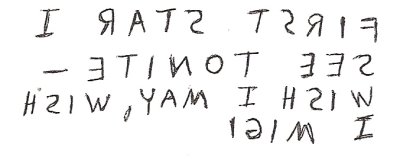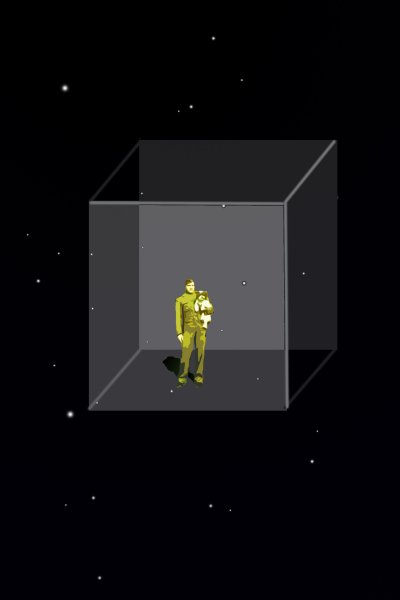
|
 
Raft
The man wore a tight-fitting yellow suit, the pockets of which he began to examine, taking out of them, one after another, a small notebook, a felt-tipped pen, some coins, a chain holding a number of keys and a wallet. He put the items on the bottom of the cube and appraised them, smiling now enigmatically. The beast approached the items, probing at them with its muzzle. It walked erratically, as if its legs were weak or injured. The man noticed this, and reached out to stroke its head. Then he opened the wallet and removed a series of photographs, arranging them in a row on the bottom of the cube. Shaking his head, he seemed to begin to cry again, although there were no tears, just a grieved expression so great it seemed carved into his features. After a while, the man stood up and walked to one end of the cube, then back to the other end, touching its side tentatively, looking out. Space abounded with stars, stars that seemed to descend all around the two beings like a cosmic snowfall. The man watched them for a long time before lying down again, on his side, the beast moving to lie beside him. They remained motionless for an hour or so, then the man stirred, got to his feet, and went to one end of the cube. He opened a compartment there, taking out half a dozen small packets that he put on the bottom of the cube through which thousands of distant stars shone. He tore open the top of one of the packets and poured some pellets of food into his palm, shaking more of them onto the bottom of the cube for the beast, which moved wobblingly toward them and devoured them hungrily. He ate slowly, and when he was finished tossed the empty packet to the other end of the cube. He sat for a while, stroking the beast's head. Shortly the man rolled over and lay quietly, sleeping. The beast curled up beside him and followed his example. An hour later, the man sat up, glancing about as if bewildered by his surroundings. He stood up, and the beast stirred and also got to its feet. The man put his palms against the side of the cube and stared out with a longing expression, as if he discovered himself, to his dismay, inside a cage. The cube moved through a sea of black space aglow with the white fire of stars visible through all of its surfaces, everywhere. Suddenly the man broke into a sort of impromptu promenading dance step, waving his arms, grinning, prancing about with the small beast following him waveringly at every motion and turn. He danced oddly and comically for half a minute. Then suddenly he collapsed, sinking to the bottom of the cube, where he arranged himself sitting in a crosslegged posture, his head pressed down into his hands. His body very slightly convulsed in a series of spasms. He appeared to be sick, or crying again. He reached out with one hand for the beast, but his fingers groped uneventfully in the air. The beast had lain down and no longer moved, or even seemed to be breathing. Its mouth was open, its tongue extended, eyes rolled back in its head. The man crawled over to it, touching it tentatively again and again, then finally moved to the other end of the cube and huddled there, looking back at the beast, shaking his head. After a while, he stood up and began writing with the pen on one side of the cube. In the middle of the writing the pen stopped functioning and he threw it down, leaving an unfinished statement on the transparent surface, which seen from the outside looked like:

The man sat down again, staring out at the stars, expressionless. An hour passed during which he remained almost completely motionless, then he slowly stood up. He picked up the small beast delicately with both hands and carried it to a corner of the cube, opened another compartment there, slid out a drawer several feet long, put the little beast inside it and slid it back into place. He made an adjustment with an inconspicuous instrument and watched as the beast was drawn outside the cube into space, visible there for a split second, the momentary image immediately obscured by the familiar permanent sight of numberless bright stars. The man walked to the other end of the cube, paced back again and continued to walk back and forth aimlessly; his head was inclined downwards as if to avert his gaze, but it confronted stars through the bottom of the cube. He ran his hand through his hair, absently at first, then in an increasingly uneasy manner. He sat down and turned his attention to the stars. He watched them as intently as someone viewing a film or play. Intermittently he got up and paced around slowly for a minute or so before sitting down again and watching. The process continued for hours, with the man becoming virtually automaton-like in his behavior. Finally, he lay down and slept again. A few hours later, when he woke, he sat up with what seemed to be great effort. He did not get to his feet, but crawled over to the packets he had removed from the compartment. He tore another one of them open, shook a couple of capsules into his hand, then swallowed them, his mouth writhing as if from a bitter taste. Then he crawled over to the photographs and picked one of them up. He held it briefly to his heart, then touched it to his lips. With a weary and enigmatic smile he lay down on his side and closed his eyes. Minutes passed and he remained inert, his fingers having curled rigidly in a way that gave his hands the appearance of claws. Hours passed. Many more hours passed, and then another space craft came from the same direction as the one that had exploded. It was bullet-shaped, about fifteen times the size of the cube and, like the cube, was transparent. The craft was a Life Finder and it approached the cube cautiously, moving with fine precision until the two craft were adjacent to each other. Inside the new arrival a mechanical creature moved about with care and deliberation. Soon, long flexible tendrils extruded from the craft to a length of two hundred meters and sinuously enveloped the cube. Inside the cube the man lay motionless. The appendages were tipped with discs which searched all about the surface of the cube, slowly in the manner of a stethoscope applied by a doctor. They held onto the cube for about ten minutes while the mechanical creature manipulated them gently. Then the tendrils were withdrawn. The bullet receded slightly from the cube and suddenly a refulgent beam, blue as starlight, crackled from the bullet into the cube, which disintegrated, portions of it flying in all directions, parts of the cube and the man spinning off and away toward the omnipresent stars. In the same instant as the cube exploded the bullet accelerated in the direction from which it had come, vanishing almost immediately. Then nothing happened; the stars continued to display themselves in the vast theater of space, like myriad cold lights hung in an infinite tree of night.
Story Copyright © 2007 by Larry Tritten. All rights reserved.
Previous: The End of the Universe by Eugie Foster | Next: Severance Pay by Shane Nelson
About the author Larry Tritten is a veteran freelance writer with more than 1500 publication credits to his name. His writing spans an enormous range, including humor (Harlan Ellison described Larry as 'the best humor writer in America'), travel (for publications such as the Boston Globe, the Miami Herald, the Chicago Tribune and Sun-Times, Newsday, and SF Chronicle), fiction (including science fiction and fantasy), erotica (at one time he was book and film editor for Hustler) and theater criticism.
About his story, Raft, Larry says: 'The story was inspired by a short story by Evan S. Connell Jr. titled The Yellow Raft about a pilot shot down in the South Pacific during WWII. I gave it a science-fiction take, just as Harlan Ellison's Year's Best American Short Stories story, The Man Who Rowed Christopher Columbus Ashore is his take on Shirley Jackson's short story, One Ordinary Day With Peanuts.'
Discuss this story on the Darker Matter Forums
Home | FAQ | Forums | Submissions | Privacy | Contact | Donations 
|
|

